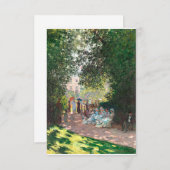
Sale prijs € 2,00.
Originele prijs € 2,66 per kaart
Je bespaart 25%
De Parc Monseau door Claude Monet Bedankkaart
Bekijk productdetailsOver Enkele bedankkaarten
Aangeboden door
Over dit ontwerp
De Parc Monseau door Claude Monet Bedankkaart
Oscar-Claude Monet (UK: /ˈmɒ neɪ/, US: /moʊneɪ, məintensich/, French: [klod mheilin]; 14 November 1840 - 5 December 1926) was a French painter and founder of impressionist painting who is seen a key precursor to modernism, especially in his attempts to paint nature as he perceived it.[1] During his long career, he was the most consistente and prolific practitioner of impressionism's filoy of espressing one's perceptions before nature, especially as applied to plein (outdoor) landscape pae inting.[2] The term "Impression onism" is derived from the title of his painting Impression, soleil, exhibited in the 1874 ("exhibition of rejects") initiated by Monet and his associates as an alternatieven to the Salon. Monet was raised in Le Havre, Normandy, and became interested in the outdoors and drawing from an early age. Although his mother, Louise-Justine Aubrée Monet, support van his ambitions to be a painter, his father, Claude-Adolphe, disapproved and wanted him to pursue a career in business. He was very close to his mother, but she died in January 1857 when he was sixteen years old, and he was sentto live with his childless, widowed but wealthy aunt, Marie-Jeanne Lecadre. He went on to study at the Academy Suisse, and under the academic history painter Charles Gleyre, where he was a classimate of Auguste Renoir. His early works include landscapes, seascapes, and portretten, but attracted little regarding. A key early impact was Eugène Boudin who introduced him to the concept of fair painting. From 1883, Monet lived in Giverny, also in northern France, where he purchased a house and property and began a brede landscaping project, including a water-lily gewicht. Monet's ambition to document the French countryside led to a method of painting the same scene many times so as to catch the changing of light and the application of the seasons. Among the best-known examples are his series of haystacks (1890-91), paintings of the Rouen Cathedral (1894), and the paintings of water lilies in his garden in Giverny that occuied him continuously for the last 20 years of his life. Frequently exhibited and successful during his lifetime, Monet's fame and popularity soared in the second half of the 20th century when he became one of the world's most famous painters and a source of inspiration for burgeoning groups of artists. When Durand-Ruel's previous support of Monet and his peers began to decline, Monet, Renoir, Pissarro, Sisley, Paul Cézanne, Edgar Degas, and Berthe Morisot exhibited their work independently; they did so under the name the Anonymous Society of Painters, Sculptors and Engravers for which Monet was a leading figuur in its formation.[12][15] He was geïnired by the style and subject matter of his slightly older contemporaries, Pissarro and Édouard Manet.[41] The group, whose title was chosen to avoid associated with any style or movement, were unified in their independence from the Salon and rejection of the prevailing academicism.[12][42] Monet gained a reputation as the foremost landscape painter of the group.[16] At the first exhibition, in 1874, Monet displayed, among others Impression, Sunrise, The Luncheon and Boulevard des Capucines. [43] The art critic Louis Leroy wrote a vijandige review. Taking particular notice of Impression, Sunrise (1872), a hazy depiction of Le Havre port and stylistic detour, he comed the term "Impression onism". Conservative critics and the public derided the group, with the term initially being ironic and denoting the painting as unfinished.[15][42] Progressieve critics praised the depiction of modern life—Louis Edmond Duranty called their style a "revolution in painting".[42] He later spijt. In het kader van de samenwerking tussen de Europese Unie en de Verenigde Staten is de Commissie van mening dat de Europese Unie een belangrijke rol moet spelen bij de verwezenlijking van de doelstellingen van het gemeenschappelijk buitenlands en veiligheidsbeleid. Monet priced Impression: Sunrise at 1000 francs but failed to sell it.[44][45][46] The exhibition was open to anyone prepared to pay 60 francs and Gave artists the opportunity to show their work without the interference of a jury.[44][45] 6] Another exhibition was held in 1876, again in oppositie to the Salon. Monet displayed 18 paintings, including The Beach at Sainte-Adresse which showcased multiple Impressonist characteristics.[28][47] For the third exhibition, on 5 April 1877, he selected seven paintings from the dozen he had made of Gare Saint-Lazare in the past three months, the first time he had "synced as many paintings of the same site, carefully coordinating their scenes and temporalities".[48] The paintings were received by critics, who especially praised the way he captured the arrial and departures of the treinen.[48] By the fourfours th exhibition his involvement was by means of negotiation on Caillebotte's part.[15] His last time exhibiting with the Impressonists was in 1882—four years before the final Impression onist exhibition.[49] Monet, Renoir, Pissarro, Morisot Cézanne and Sisley proceeded to experiment
Ontwerp van international designer
Klant beoordelingen
3.0 van 5 sterren beoordeling2 aantal beoordelingen
2 Reviews
Beoordelingen voor identieke producten
5 van 5 sterren beoordeling
Door Mirjam S.10 april 2025 • Geverifieerde aankoop
Enkele bedankkaart, maat: 8,9 x 12,7 cm, papier: Signature Mat, hoeken: Vierkant
De kaarten zijn prachtig geworden, compliment.
1 van 5 sterren beoordeling
Door MALIKA P.14 november 2025 • Geverifieerde aankoop
Enkele bedankkaart, maat: 8,9 x 12,7 cm, papier: Signature Mat, hoeken: Vierkant
Slecht afgewerkte randen .
Tags
Andere Info
Product ID: 256740891500127557
Ontworpen op: 5-10-2022 11:07
Rating: G
Recent bekeken items



